Psoriasis: Shedding Light on a Misunderstood Condition
By Dr Helmi Ismail, Medical Advisor of PMCare
Psoriasis is one of the most common skin conditions in the world – affecting anything from 2 to 3 % of the world population, involving people of all ages, even infants – and yet terribly misunderstood and stigmatized.
The mechanism of disease
The condition is characterized by raised plaques of inflamed, red skin and white scales – appearing on various parts of the body, including the scalp, elbows, and knees – that can “flake off.” These “flakes” are essentially dead squashed cells resulting from what occurs when the immune system sends out faulty signals that speed up the growth cycle of the skin cells – forming extra cells with extra layers or “plaques” at the surface that grow very fast, then dying earlier and finally shed off.
In normal skin (left), cell growth is much slower – taking almost a month for the bottom layer of epidermal cells to reach the top layer of skin – and thus no such “flakes” are formed at the skin’s surface.
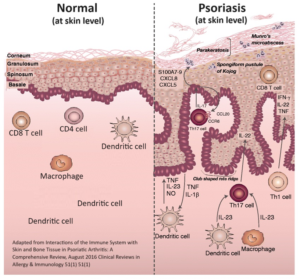
Clinical manifestation
Symptoms of psoriasis vary from person to person, but typically the lesions appear as patches of thick, red skin with silvery-white scales that may itch or burn. They are typically on the elbows, knees, scalp, trunk, palms, and soles of the feet. Dry, cracked skin that itches may bleed when scratched.
The lesion might be confused with eczema.
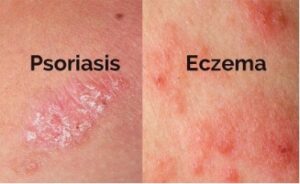
Eczema is usually associated with allergies and asthma, typically developing in childhood and may resolve with age. Up to 20% of children have eczema but only 1% to 3% remain well into adulthood. Eczema causes redness and inflammation but may also produce dry, itchy patches of skin that seep clear fluid which results in a crust. The red patches caused by psoriasis are typically raised and may have a silvery or scaly appearance. Eczema tends to react more severely to sunlight, whereas UV light may slow the progression of psoriasis.
Population involved
More than 125 million people worldwide, or 2 to 3 percent of the total population have psoriasis, according to the World Psoriasis Day consortium. Studies also show that between 10 and 30 percent of people with psoriasis also develop psoriatic arthritis. (Source: http://www.psoriasis.org/learn_statistics).
Taking the population of Malaysia as 34 million, it may be estimated that there are 0.85 million (or 850,000) sufferers of the condition.
With that number of individuals involved, PMCare aims to shed light on this complex condition and raise awareness about the importance of understanding and supporting those living with psoriasis.
Nail involvement
Psoriatic nail disease has many clinical signs. Most psoriatic nail disease occurs in patients with clinically evident psoriasis – an estimated 10-55% of all patients with psoriasis have psoriatic nail disease. However, it only occurs in less than 5% of patients with no other cutaneous findings of psoriasis.
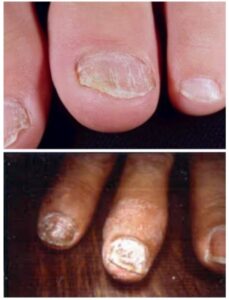
Joint involvement
Of those with psoriasis, 1 in 5 is expected to develop joint problems which may be debilitating.
To complicate matters, psoriasis appears to occur before the onset of psoriatic arthritis in 60-80% of patients (occasionally by as many as 20 years, but usually by less than 10 years)!
The joint deformity might need surgical intervention. A 1998 study from Switzerland found that about 7% of patients with psoriatic arthritis required musculoskeletal surgery; with the first operation at an average of 13.9 years (range 1-46) after onset of joint disease.
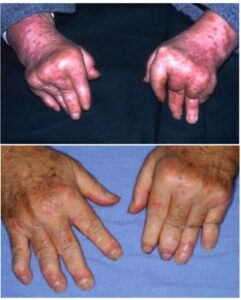
Non-physical aspect of the disease
However, the impact of psoriasis extends far beyond the physical symptoms. Individuals with psoriasis often face significant social and emotional challenges due to the widespread misconceptions and stigma surrounding the condition. The appearance of the typical plaques alone can be distressing for those affected, leading to feelings of self-consciousness, social isolation, and even depression.
On top of that, many people mistakenly believe that psoriasis is contagious or a result of poor hygiene, leading to social exclusion and discrimination.
This lack of understanding can have a profound impact on the well-being of those living with psoriasis. Studies have shown that individuals with psoriasis are more likely to experience anxiety, depression, and even suicidal thoughts compared to the general population. The emotional burden of the condition can be just as debilitating as the physical symptoms, and it is crucial that we, as a society, work to address this issue.
Treatment
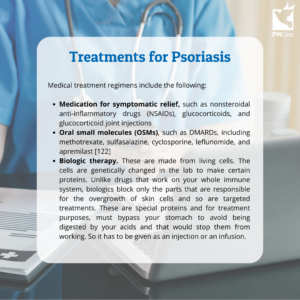
Conclusion
Now that we understand that at its core, psoriasis is caused by an overactive immune system that triggers the rapid growth and shedding of skin cells. This results in the formation of thick, scaly, and often painful patches on the skin, which can appear on various parts of the body. It is not infectious and is mostly treatable.
It is essential to together create more inclusive and supportive environments for individuals with psoriasis. This can involve promoting diversity and representation in media and advertising, encouraging open discussions about the condition, and fostering a culture of empathy and understanding. By normalizing the discussion around psoriasis and celebrating the resilience of those affected, we can help empower individuals to feel comfortable and confident in their own skin.
By providing accurate information about the causes, symptoms, and management of the condition, we can help dispel the myths and misconceptions that perpetuate the stigma. Healthcare professionals, patient advocacy groups, and public health organizations all have a vital role to play in this effort, ensuring that the public understands the true nature of psoriasis and the challenges faced by those living with it.
In conclusion, psoriasis is a complex and often misunderstood condition that requires greater awareness and understanding. By educating the public, fostering inclusive environments, and supporting ongoing research, we can work towards a world where individuals with psoriasis are empowered, supported, and free from the burden of stigma. I am committed to playing a role in this important mission, and I encourage everyone to join me in shedding light on this often overlooked, yet highly prevalent, skin condition.
References:
- Interactions of the Immune System with Skin and Bone Tissue in Psoriatic Arthritis: A Comprehensive Review, August 2016 Clinical Reviews in Allergy & Immunology 51(1)
-
Psoriasis statistics. (n.d.). https://www.psoriasis.org/psoriasis-statistics/
- STATISTIK PENDUDUK MALAYSIA KINI MENCECAH 34 JUTA ORANG. (2024, May 20). Majlis Keselamatan Negara. https://www.mkn.gov.my/web/ms/2024/05/20/statistik-penduduk-malaysia-kini-mencecah-34-juta-orang
- Autoimmunity | Immune Deficiency Foundation. (n.d.). https://primaryimmune.org/understanding-primary-immunodeficiency/what-is-pi/autoimmunity
- Avena-Woods C. (2017). Overview of atopic dermatitis. The American journal of managed care, 23(8 Suppl), S115–S123.
- Psoriatic Arthritis, Ritchlin CT, Colbert RA, Gladman DD. N Engl J Med. 2017 Mar 9. 376 (10):957-970.
- Musculoskeletal surgery in psoriatic arthritis, Zangger P, Gladman DD, Bogoch ER. J Rheumatol. 1998 Apr. 25 (4):725-9.

